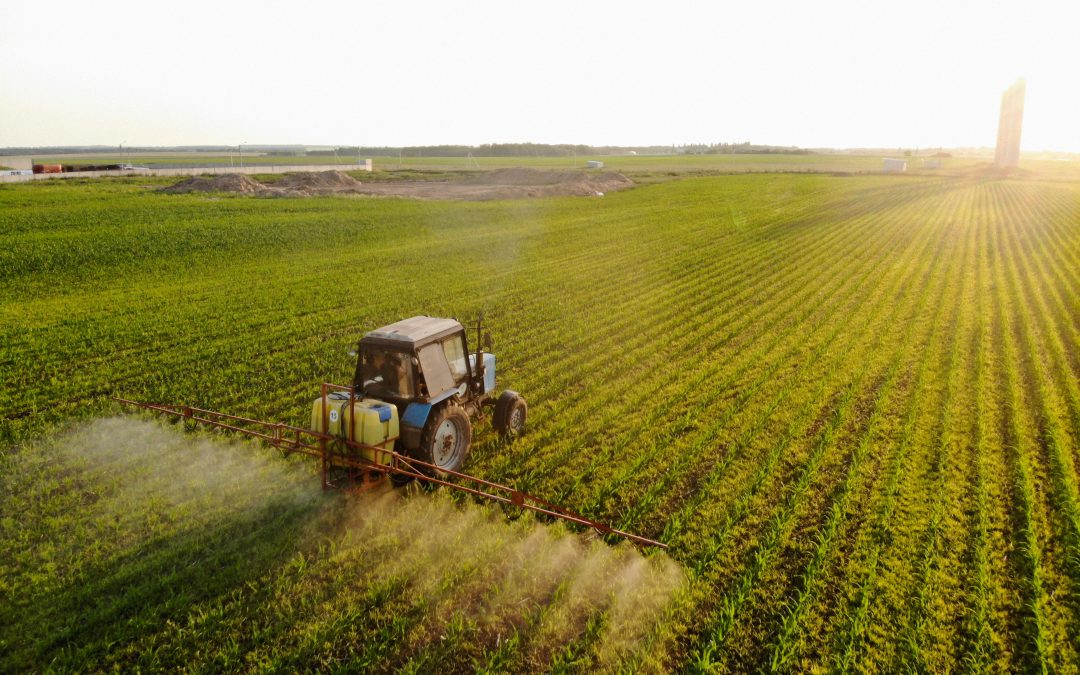
by HefeFertilizer | Apr 22, 2024 | NEWS
Every April 22nd, the world comes together to celebrate Earth Day, a date aimed at raising awareness about the importance of protecting our planet and promoting actions that foster environmental sustainability. This day, which began to be celebrated in 1970, has gained even greater relevance today, where global environmental challenges demand immediate attention and action. One of the fundamental aspects in this struggle for environmental preservation is agriculture, an activity that, paradoxically, can have both negative and positive impacts on the terrestrial ecosystem.
The Vital Role of Agriculture
Agriculture is the cornerstone of human civilization. Since the dawn of history, agriculture has been the basis for the survival and development of societies. However, the way agriculture is practiced has evolved greatly over the centuries, and its impact on the environment has changed accordingly.
Today, agriculture not only faces the challenge of feeding a constantly growing world population but also the imperative of doing so in a sustainable and environmentally friendly manner. Sustainable agriculture is defined as that which meets current food production needs without compromising the ability of future generations to do the same. In other words, it is about producing food in a way that protects natural resources and minimizes environmental impact.
Agriculture and the Environment
The link between agriculture and the environment is complex and multifaceted. On one hand, agriculture is one of the main causes of deforestation, loss of biodiversity, water pollution, and greenhouse gas emissions. The expansion of farmland at the expense of forests and other natural ecosystems has led to the destruction of critical habitats for numerous species, thus contributing to global biodiversity loss. Additionally, the intensive use of pesticides and fertilizers in agriculture can contaminate soil and water, negatively affecting human health and the environment overall.
On the other hand, agriculture can also play a fundamental role in environmental conservation and restoration. Sustainable agricultural practices, such as organic farming, agroecology, and regenerative agriculture, are designed to minimize negative environmental impacts and promote the conservation of natural resources. These practices include the use of cultivation techniques that improve soil health, water conservation, crop diversification, and the promotion of biodiversity on farmsteads.
Earth Day and Sustainable Agriculture
Earth Day is an opportunity to reflect on the relationship between agriculture and the environment and to reaffirm our commitment to promoting sustainable agricultural practices. It is a reminder that if we want to protect our planet and ensure a healthy future for future generations, we must transform the way we produce and consume food.
In this regard, it is important for governments, agricultural businesses, farmers, and society as a whole to work together to promote the adoption of sustainable agricultural practices and encourage responsible production and consumption of food. This may involve the implementation of public policies that incentivize sustainable agriculture, investment in research and development of innovative agricultural practices, and education and awareness-raising of the public about the importance of agriculture for the health of the planet.
Earth Day is an occasion to reflect on the state of our planet and reaffirm our commitment to its protection and preservation. In this context, agriculture plays a crucial role, as both its negative and positive impacts on the environment are significant. Promoting sustainable agricultural practices is essential to ensuring a healthy future for our planet and future generations. Therefore, on this Earth Day, let us renew our commitment to working together towards a more sustainable and equitable future for all.

by HefeFertilizer | Apr 9, 2024 | NEWS
In the fields that compose the landscape of our planet, the interaction between soil and plants is a choreography that determines the fate of harvests. Behind every ear of golden corn, every row of lush tomatoes, and every wheat sprout swaying in the breeze lies a fundamental secret: the importance of using fertilizers in the cultivation of healthy and abundant food.
Fertilizers are an essential tool in modern agriculture. They are designed to supplement the essential nutrients that plants need to grow and thrive. In a world where the demand for food is constantly increasing due to population growth, maximizing crop yield has become more critical than ever. This is where fertilizers come into play and the importance of their use. They act as the necessary boost to ensure abundant and high-quality harvests.
Essential Nutrients for Plant Growth
Plants need a variety of nutrients to develop properly. These nutrients, including nitrogen, phosphorus, potassium, calcium, magnesium, and a range of micronutrients, are absorbed from the soil through the roots. They are used in a series of key biological processes, from photosynthesis to the formation of cellular structures.
The soil naturally contains a variable amount of these nutrients, but over time, intensive agriculture and continuous cropping can deplete the levels available in the soil. This is where fertilizer application becomes an essential practice to maintain soil fertility and ensure that plants have access to the nutrients they need to thrive.
Impact of Fertilizers on Crop Yield
Proper fertilizer application can have a significant impact on crop yield and quality. Nitrogen, for example, is crucial for plant growth and protein production. A lack of nitrogen can lead to poor plant growth and a decrease in crop production. The addition of nitrogen fertilizers can increase plant growth and significantly improve crop yield.
Similarly, phosphorus is vital for root development and the formation of flowers and fruits. Soils low in phosphorus can limit plant growth and reduce crop quality. The application of phosphorus-containing fertilizers can improve plant health and increase crop production.
Sustainability and Fertilizer Management
While fertilizers are an invaluable tool for improving crop performance, their excessive or improper use can have negative consequences for the environment. Excess nutrients can leach into groundwater or runoff into nearby bodies of water, causing eutrophication and damaging aquatic ecosystems.
Therefore, it is crucial to adopt sustainable fertilizer management practices that balance the need to maximize crop yield with environmental protection. This may include the use of slow-release fertilizers, precise application based on soil analysis, crop rotation, and the use of cover crops to improve soil health and reduce nutrient loss.
In conclusion, fertilizers play a fundamental role in the success of agricultural crops. They provide the necessary nutrients for healthy and abundant growth. However, their use must be carefully managed to ensure the long-term sustainability of agriculture and environmental protection. By responsibly harnessing the power of fertilizers, we can cultivate nutritious and abundant food for future generations.

by HefeFertilizer | Mar 27, 2024 | NEWS
In an ambitious move towards sustainability and environmental protection, the European Union (EU) has recently announced its decision to require all food packaging marketed in its territory to be recyclable and free of harmful chemicals. This initiative, which seeks to address the environmental challenges associated with packaging waste and chemical contamination, marks a significant milestone in the EU’s efforts to promote more responsible and environmentally friendly business practices.
The announcement comes at a crucial time, when public awareness of environmental issues, such as plastic pollution and exposure to hazardous chemicals, is on the rise. With growing concern about the impact of food packaging on human health and the environment, the EU has taken the lead in implementing concrete measures to address these problems.
One of the main provisions of this new regulation is the obligation for all food packaging to be recyclable. According to data provided by the European Commission, it is estimated that currently only 30% of plastic food packaging used in the EU is recyclable, which means that the vast majority of this packaging ends up in landfills or in the environment, contributing to pollution and waste of natural resources. With this new regulation, this figure is expected to increase significantly and reach a 100% recyclability rate by 2030.
In addition to the recyclability requirement, the EU is also cracking down on the use of harmful chemicals in food packaging. According to a report by the European Chemicals Agency (ECHA), it is estimated that more than 600,000 tons of hazardous chemicals are used annually in the manufacture of food packaging in the EU. These substances, which include phthalates, bisphenols and PFASs, have been the subject of concern due to their potential adverse effects on human health and the environment. The new regulation is expected to drastically reduce the use of these chemicals and ensure the safety of food packaging for European consumers.
This initiative will not only benefit European consumers by ensuring the safety of the food products they consume, but will also have a positive impact on the food industry and the packaging sector. Packaging manufacturers and food producers are expected to quickly adapt their practices to comply with the new regulations, which will create opportunities for innovation and investment in more sustainable packaging solutions.
In summary, the European Union’s decision to require all food packaging to be recyclable and chemical-free represents an important step forward in the fight against pollution and the promotion of more responsible business practices. While the challenges are real, the long-term benefits to human health and the environment fully justify these efforts. The EU is setting a precedent for the rest of the world in sustainability and environmental protection, demonstrating that it is possible to strike a balance between economic development and preserving our planet for future generations.

by Hefe Fertilizer | Mar 9, 2024 | NEWS
Agriculture is the backbone of our society, providing the food we consume on a daily basis. However, this vital sector faces constant challenges, and currently, farmers’ strikes are causing concern around the world. In times of uncertainty such as these, it is essential to have effective solutions that maximize crop yields and ensure food security. In this context, Hefe Fertilizer’s organic fertilizers emerge as indispensable allies for farmers in the quest for sustainable, high-quality agricultural production.
Farmer strikes represent a multifaceted challenge that affects the entire food supply chain. From labor shortages to transportation and distribution disruptions, farmers face significant obstacles that threaten the productivity and profitability of their crops. In this scenario, optimizing available resources becomes crucial, and Hefe Fertilizer’s organic fertilizers offer an effective and sustainable solution.
The key to meeting today’s challenges lies in improving soil health and increasing plant resistance to adverse conditions. Hefe Fertilizer’s organic fertilizers are designed to nourish the soil in a balanced way, providing the essential nutrients plants need to grow strong and healthy. By promoting soil biodiversity and stimulating beneficial microbial activity, these fertilizers improve soil structure, increase its water and nutrient holding capacity, and reduce erosion, thus contributing to crop resilience to extreme weather conditions and other stress factors.
In addition, Hefe Fertilizer’s organic fertilizers are a safe and environmentally friendly option, in line with increasing consumer demands and government regulations. Made from renewable organic raw materials, these fertilizers not only nourish plants effectively, but also promote long-term soil health without leaving harmful residues or polluting water resources.
In times of farmer strikes, operational efficiency and adaptability are crucial to maintain continuity of agricultural production. Hefe Fertilizer’s organic fertilizers offer a comprehensive solution that helps farmers overcome today’s challenges and reach their full productive potential. By investing in soil health and plant well-being, farmers can successfully meet the challenges of the present and build a more sustainable and prosperous agricultural future for generations to come.
In conclusion, at a time when agriculture faces unprecedented challenges, Hefe Fertilizer’s organic fertilizers stand out as an invaluable tool to maximize agricultural yields, promote sustainability and ensure food security. As a trusted partner committed to farmer success, Hefe Fertilizer continues to innovate and deliver solutions that drive progress and resilience in the field.

by Hefe Fertilizer | Jan 20, 2024 | NEWS
A technological leap that revolutionizes the way we farm. From automation to crop anticipation, we will explore how this evolution redefines agricultural efficiency.
The reality of agriculture has undergone a significant change thanks to the implementation of automated and digitized processes. The introduction of these Stage 3.0 practices has streamlined and modernized our approach to agricultural work, allowing us to leverage technological advances such as computer vision, machine learning, the Internet of Things (IoT) and sensor technology in agronomy. The abundance of data collected during this period has been staggering, exceeding our expectations.
We are now in a crucial transition to agriculture 4.0, marked by the maturation and advanced processing of the digital data obtained in the previous stage. This Big Data not only drives precision in production and yield applications, but also opens up new possibilities with emerging technologies such as quantum computing and Artificial Intelligence (AI) in the agri-food sector.
The shift from 3.0 to 4.0 agriculture redefines the initial paradigm of pursuing faster and more abundant agriculture. Now, it is about understanding that each piece of data collected contributes to fairly address the economic reality of the field, minimizing the use of agricultural applications and reducing the environmental impact.
The Age of Big Data
The figures collected since 2020 are shocking, surpassing all of human history in agricultural data collection. Projections indicate that these figures will triple by 2025, reflecting a quantitative and qualitative leap in the agricultural industry.
The information collected offers unprecedented accuracy, replacing estimates based on intuition and past experience. These data guide the correction of failures, the efficient allocation of resources at each stage and the accurate evaluation of successes in agricultural actions.
Optimization and Sustainability
Data guides us to anticipate crop results, allowing us to maximize production, reduce costs and mitigate environmental impact. Agriculture 4.0 distinguishes itself by doing more with less effort, optimizing yields and minimizing the use of inputs. Through the volatility of cycles, profitability is maintained.
In short, this data empowers agricultural stakeholders to make more effective decisions in the future, overcoming past practices and embracing an era of smarter, more sustainable agriculture.

by Hefe Fertilizer | Jan 20, 2024 | NEWS
In Mexico, HEFE brand products are notably prominent, thanks to its exclusive distributor, Polaquimia, part of the Polak Group, which is one of the world’s leading food suppliers.
Mexico, with a territory that is more than double the total land area of the countries of the Central American Integration System (SICA) bloc, stands out in agriculture with more than 21.2 million fertile hectares, making it the 11th largest agricultural producer in the world.
Mexico’s vast arable area also implies the need to protect it against threats such as climate change, uncontrolled deforestation, population growth, and financial and energy crises. These factors represent significant challenges that affect the country’s agricultural productive capacity.
CHALLENGE IN MEXICO
In Mexico, soil degradation and loss of organic matter have reached alarming levels in the last decade. This problem, common in countries with significant agricultural production, is due to the exponential increase in agricultural activity to meet high food demand. The widespread focus on farming without regard for conservation and the preference for mineral fertilizers have contributed to worsening soil health in this period.
In addition to rapid soil degradation, Mexico faces climatic and environmental conditions conducive to the proliferation of insect pests and fungal diseases.
Faced with soil degradation and challenging conditions, Mexican growers are looking to invest in plant health and plant nutrition solutions that are more innovative than traditional practices. The focus is on biotech products designed to induce physiological processes directly in the plant, as opposed to the direct application of mineral nutrients in the soil. In addition, opting for products with a high organic matter composition may be key to moving towards an agriculture that protects soil health and avoids soil non-viability over successive crop cycles.
Biosolutions in Mexico: adaptation with difficulties
The Mexican agri-food industry could experience enormous benefits from the promotion of and investment in biosolutions. Although there is significant technological adoption from Spanish, European and North American suppliers, demand in the country is not yet fully satisfied. Companies specializing in agricultural biosolutions, mainly biostimulants and bionutrients, face significant challenges in terms of slowness and costs in obtaining registrations for this type of products, with a validation period of 16 to 24 months and costs that can reach up to US$20,000 per product for analysis, studies and official registrations.






